Form SC TO-C MONSANTO CO /NEW/ Filed by: BAYER AKTIENGESELLSCHAFT
UNITED STATES
SECURITIES AND EXCHANGE COMMISSION
Washington, D.C. 20549
SCHEDULE TO
(RULE 14d-100)
Tender Offer Statement Pursuant to Section 14(d)(1) or 13(e)(1) of the Securities Exchange Act of 1934
Monsanto Company
(Name of Subject Company)
Bayer Aktiengesellschaft
(Names of Filing Person (Offeror))
Common Stock, $0.01 par value per share
(Title of Class of Securities)
61166W101
(CUSIP Number of Class of Securities)
Dr. Jan Heinemann
Bayer Aktiengesellschaft
BAG-LPC-MA
Kaiser-Wilhelm-Allee, Q26
51368 Leverkusen
Germany
(+49) 214 30-1
(Name, Address and Telephone Number of Person Authorized to Receive Notices and Communications on Behalf of Filing Persons)
Copy to:
Matthew G. Hurd
Eric M. Krautheimer
Sullivan & Cromwell LLP
125 Broad Street
New York, NY 10004
(212) 558-4000
CALCULATION OF FILING FEE
|
Transaction Valuation |
|
Amount of Filing Fee |
|
Not applicable |
|
Not applicable |
|
x |
Pursuant to General Instruction D to Schedule TO, no filing fee is required in connection with this filing as it contains only preliminary communications made before the commencement of a tender offer. |
|
|
|
|
o |
Check the box if any part of the fee is offset as provided by Rule 0-11(a)(2) and identify the filing with which the offsetting fee was previously paid. Identify the previous filing by registration statement number, or the Form or Schedule and the date of its filing. |
|
Amount Previously Paid: |
Not applicable |
Filing Party: |
Not applicable |
|
Form or Registration No.: |
Not applicable |
Date Filed: |
Not applicable |
|
x |
Check the box if the filing relates solely to preliminary communications made before the commencement of a tender offer. |
Check the appropriate boxes below to designate any transactions to which the statement relates:
|
|
x |
third-party tender offer subject to Rule 14d-1. |
|
|
o |
issuer tender offer subject to Rule 13e-4. |
|
|
o |
going-private transaction subject to Rule 13e-3. |
|
|
o |
amendment to Schedule 13D under Rule 13d-2. |
Check the following box if the filing is a final amendment reporting the results of the tender offer: o
If applicable, check the appropriate box(es) below to designate the appropriate rule provision(s) relied upon:
|
|
o |
Rule 13e-4(i) (Cross-Border Issuer Tender Offer) |
|
|
o |
Rule 14d-1(d) (Cross-Border Third Party Tender Offer) |
EXHIBIT INDEX
Exhibit 99.1 Slides of Presentation to Bayer employees, dated June 8, 2016.
Exhibit 99.2 Transcript of Presentation to Bayer employees, dated June 8, 2016.
Exhibit 99.3 Letter to Bayer employees following Presentation, posted June 9, 2016.
Exhibit 99.1
8 June 2016 Transforming Today, Leading Tomorrow: Advancing Our Leadership Strategy Liam Condon Page 1 CROP SCIENCE GLOBAL TOWNHALL MEETING
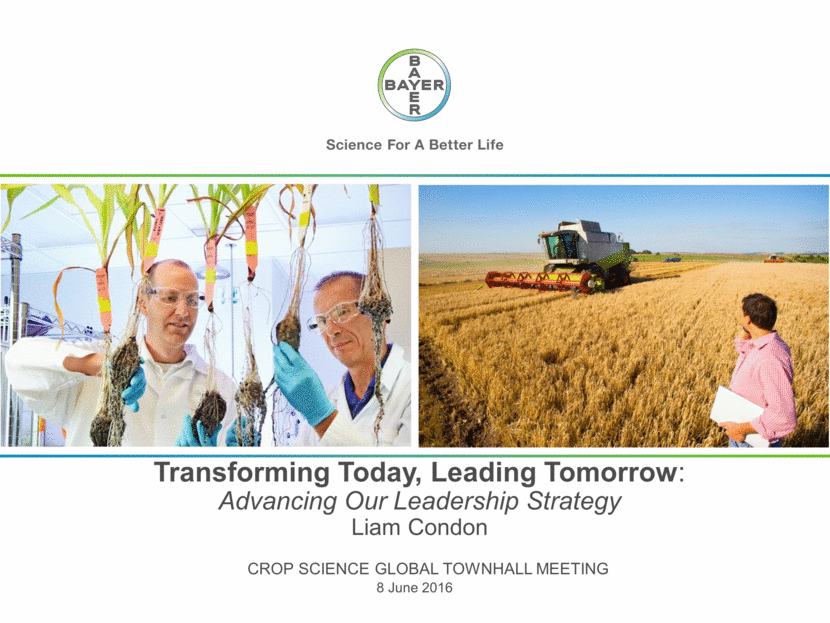
This communication relates to a proposed offer by Bayer Aktiengesellschaft or its subsidiaries (“Bayer”), to purchase all of the outstanding shares of common stock, par value $0.01 per share, of Monsanto Company, a Delaware corporation (“Monsanto”). This communication is neither an offer to purchase nor a solicitation of an offer to sell shares of Monsanto. No tender offer for the shares of Monsanto has commenced at this time. At the time a tender offer for the shares of Monsanto is commenced, Bayer will file tender offer materials (including an Offer to Purchase, a related Letter of Transmittal and certain other offer documents) with the Securities and Exchange Commission (the “SEC”) with respect to the tender offer. Any definitive tender offer documents will be mailed to the stockholders of Monsanto. STOCKHOLDERS OF MONSANTO ARE URGED TO READ THE RELEVANT TENDER OFFER MATERIALS WHEN THEY BECOME AVAILABLE BECAUSE THEY WILL CONTAIN IMPORTANT INFORMATION ABOUT THE TENDER OFFER THAT STOCKHOLDERS SHOULD CONSIDER BEFORE MAKING ANY DECISION REGARDING THE TENDER OF THEIR SHARES. Stockholders of Monsanto will be able to obtain free copies of these documents (if and when available) and other documents filed by Bayer with the SEC through the website maintained by the SEC at www.sec.gov. Legal Disclaimer Page 2 Global Crop Science Townhall • 8 June 2016
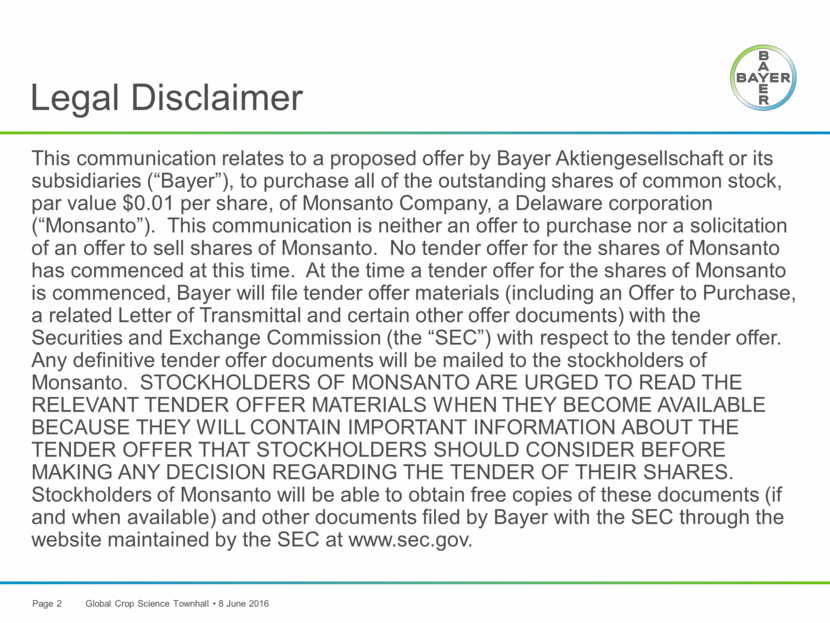
Agenda Acquiring Monsanto to advance the next generation of farming Q&A Advancing Our Leadership Strategy Agricultural Commercial Operations (ACO) Research & Development (R&D) Other Functions Q&A Page 3 Global Crop Science Townhall • 8 June 2016
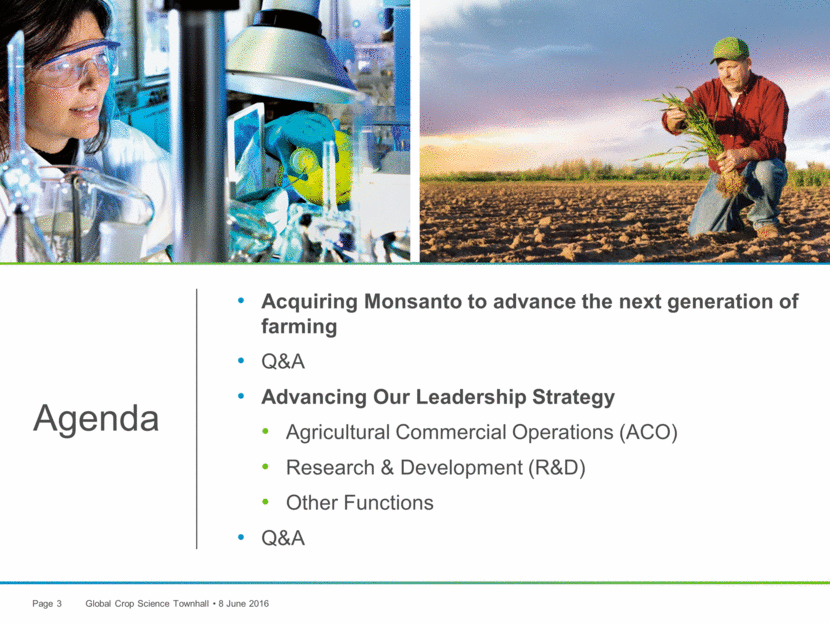
Compelling driver for Life Science Portfolio Creates an industry leader in Crop Science with integrated offering of Seeds & Traits, Crop Protection, Biologics and Digital Farming Creates an Innovation Powerhouse to deliver integrated solutions for the next generation of farming Reinforces Bayer as a Life Science company with leadership positions in its core business segments Page 4 Global Crop Science Townhall • 8 June 2016
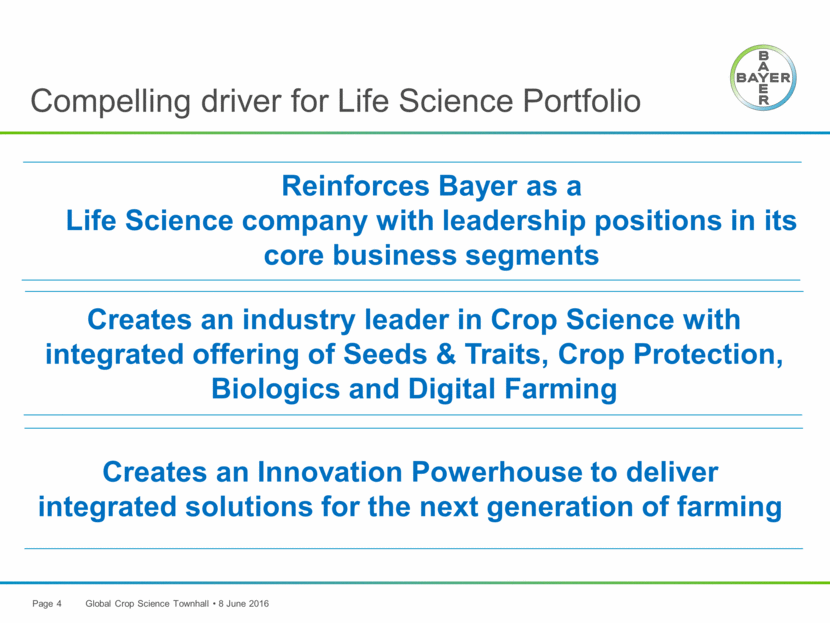
Beneficial for all stakeholders Bayer Next logical step to reinforce Bayer as a Life Science company Well balanced portfolio of Health Care and Crop Science Business Crop Science Leading integrated agriculture business delivering valuable and innovative solutions for farmers Significant growth potential in a very attractive industry Employees Working for an industry leader Attractive career opportunities at a larger and more diversified global franchise Customers Creating an Innovation Powerhouse Broad portfolio: Seeds & Traits, Crop Protection, Biologics and Digital Farming platforms Investors Substantial value for both companies’ shareholders Substantial premium for Monsanto’s shareholders Page 5 Global Crop Science Townhall • 8 June 2016
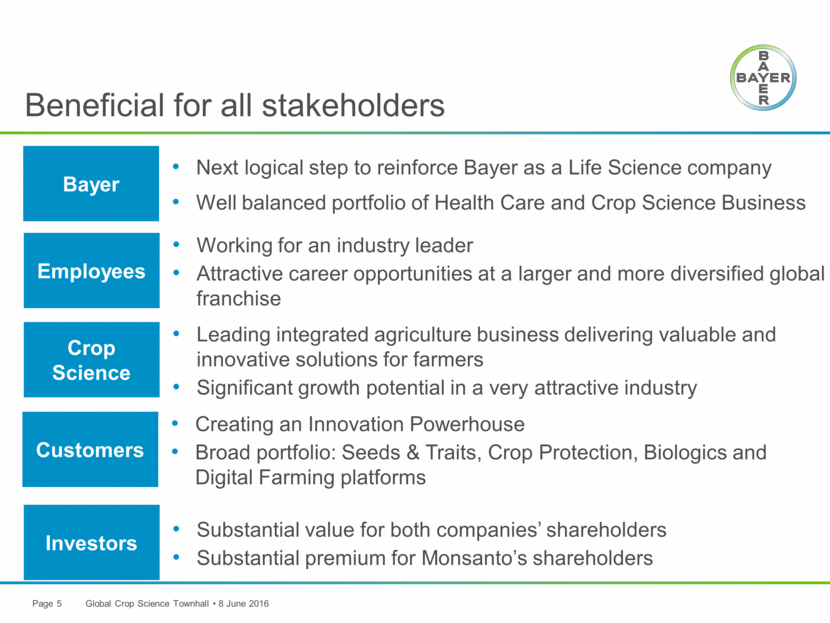
Combination Addresses Fundamental Global Challenges ~10 billion People on the planet by 2050 +60% Productivity increase required to feed the planet by 2050 +16% Rising per capita protein intake by 2024 -17% -17% Biophysical effect of climate change shocks on yields by 2050 Declining hectares of farmland per capita by 2050 OECD-FAO AGRICULTURAL OUTLOOK 2015-2024 €120 billion Estimated Ag input market size by 2025 from ~€85bn in 20153 United Nations 2015 Nelson1 / FAO2 From 0.218 ha/capita in 2015 to 0.181 ha/capita in 20502 FAO 2 1Nelson et. al. (2014) 2FAO 2016 "Climate change and food security" 3This includes Seeds & Traits and Crop Protection Page 6 Global Crop Science Townhall • 8 June 2016
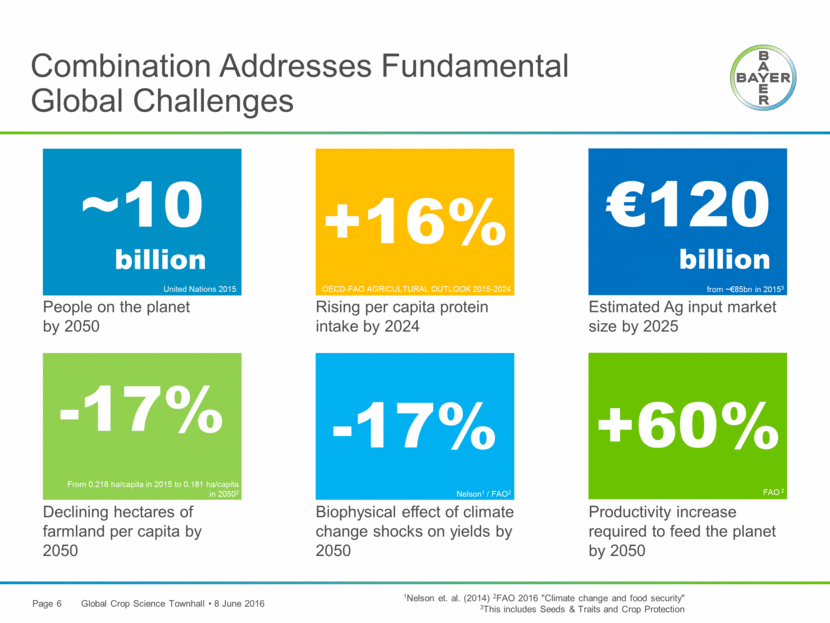
Integrated Solutions Across Crop Protection and Seeds & Traits Crop Protection Seeds & Traits Monsanto Bayer Crop Science Best-in-class Seeds & Traits portfolio Focus on “yield” Breeding and trait development focus Advanced Digital Farming platform Best-in-class Crop Protection portfolio Focus on “Plant Health” Excellence in chemistry Biologics platform Access to complete Life Science technology platform Bayer CS + Monsanto Integrated Platform Commercial packages across a broad set of key crops and geographies Strong integrated product offerings Strong R&D platform, Digital Farming beginning to serve as “integrator” Page 7 Global Crop Science Townhall • 8 June 2016
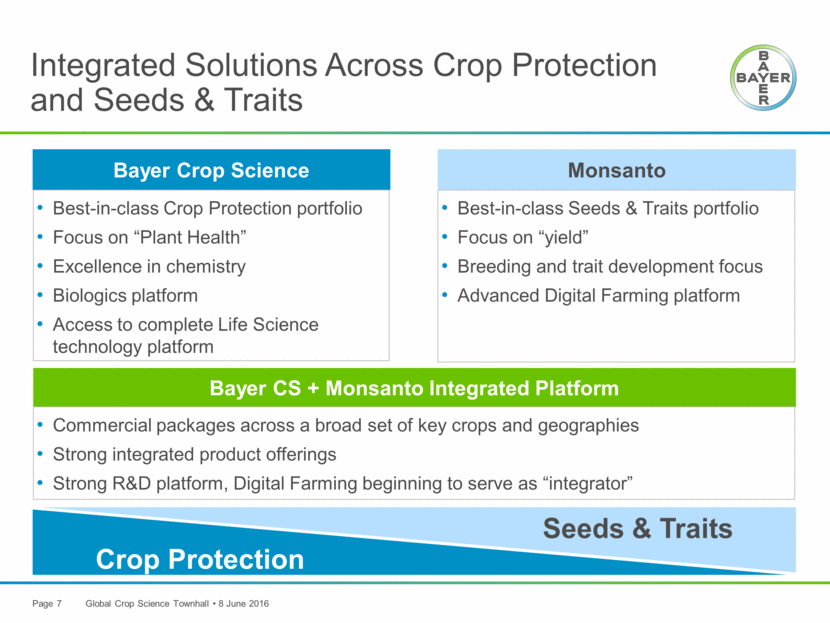
Combination of Superior Products and Services Enables Integrated Crop Solutions Seeds & Traits Seeds Treatment Weed Management Pest Management Disease Management Tailor-made customer solutions that holistically enhance yield and sustainability ensuring safe, healthy and affordable food Full optimization of all inputs over the growing cycle Additional Services + Consultancy Digital Farming + Page 8 Global Crop Science Townhall • 8 June 2016
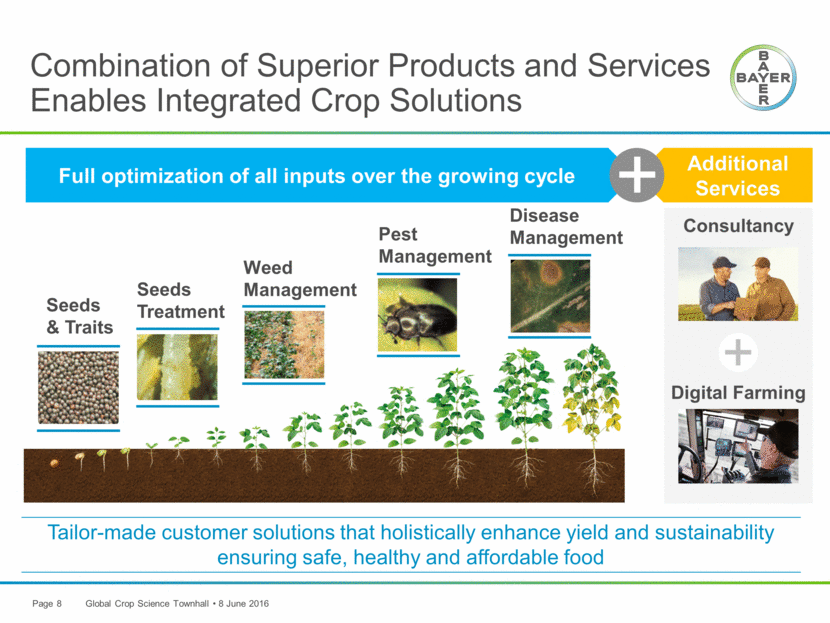
11.4% 10.6% Creation of an Innovation Powerhouse Seeds & Traits Crop Protection Total 10.6% 8.5% % of Sales Well positioned to deliver sustainable advances in agriculture for an increasing global population Capabilities and critical mass in all relevant R&D platforms Breeding Traits (GM and non-GM) Chemistry Biologics Seed Treatment Digital Farming Cross-technology capabilities Broad and deep combined R&D pipeline 2015 Pro Forma R&D Investment (€bn)1 1based on company information and internal calculations excl. synergies (at avg. 2015 Fx rate USD/EUR=1.11) assumes Dow/DuPont and ChemChina/Syngenta transactions completed 2BASF: includes ~€150 million for Plant Science 2 Page 9 Global Crop Science Townhall • 8 June 2016 2.5 1.6 1.3 0.7 Bayer CS + Monsanto Dow Ag + DuPont Ag Syngenta + ChemChina Ag BASF Ag
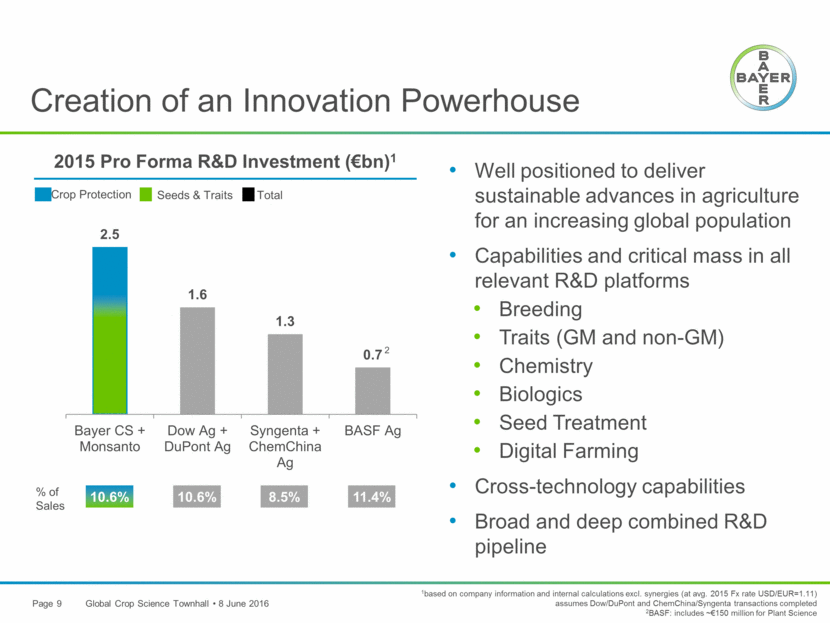
Creating a Global Leader in ~€85bn Agriculture Industry Bayer Crop Science + Monsanto 2015 Pro Forma Sales (€bn)1 Crop Protection Seeds & Traits 2 Dow Ag + DuPont Ag Syngenta + ChemChina Ag BASF Ag 1based on company information and internal calculations (at avg. 2015 Fx rate USD/EUR=1.11) assumes Dow/DuPont and ChemChina/Syngenta transactions completed 2excludes Adama non-Ag sales Page 10 Global Crop Science Townhall • 8 June 2016 5.8 14.6 14.8 23.1
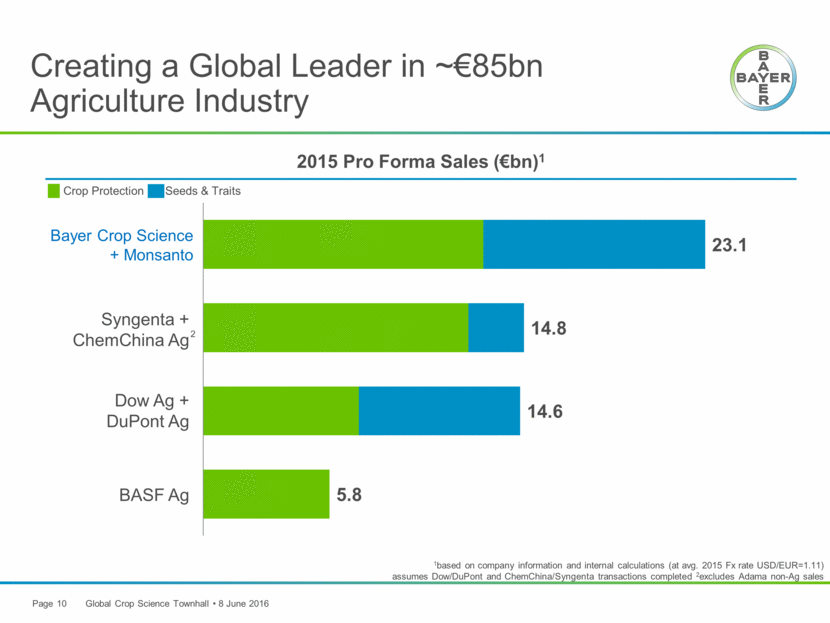
Overall reception of Bayer’s offer to acquire Monsanto
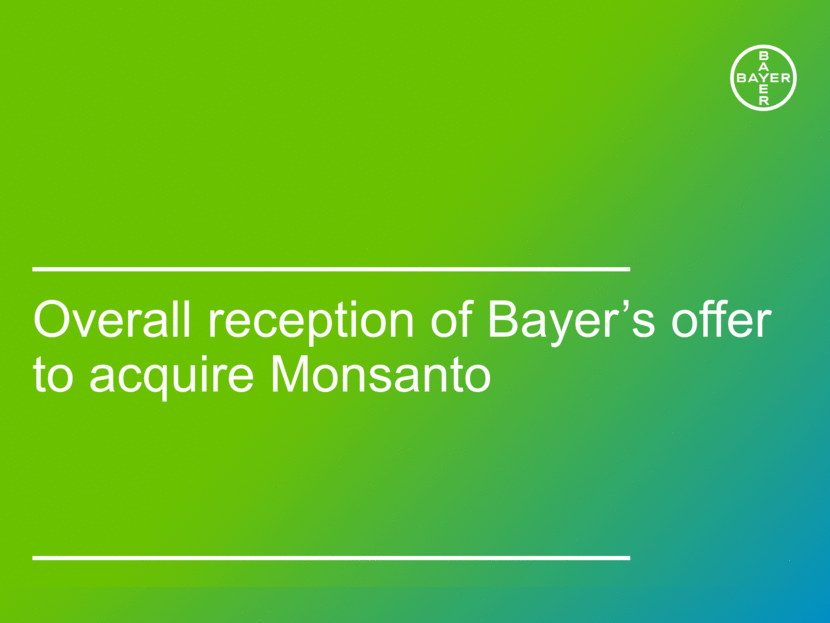
Wir lindern mit Monsanto den Hunger? - May 29, 2016 Monsanto rejects Bayer bid but leaves door open - May 28, 2016 Why Bayer’s Big Monsanto Bid Has Fallen Flat - May 23, 2016 Monsanto may strain to make case against Bayer bid - May 23, 2016 Bayer ready to beef up offer for Monsanto - May 29, 2016 Bayer launches $62bn cash bid for Monsanto: German group seeks to create ‘global agricultural leader’- May 23, 2016 Bayer's Monsanto Offer May Be Too Much and Not Enough - May 23, 2016 Bayer CEO Invites Environmental Groups to Talk About Monsanto Bid - May 28, 2016 High media exposure, overall Page 12 Global Crop Science Townhall • 8 June 2016
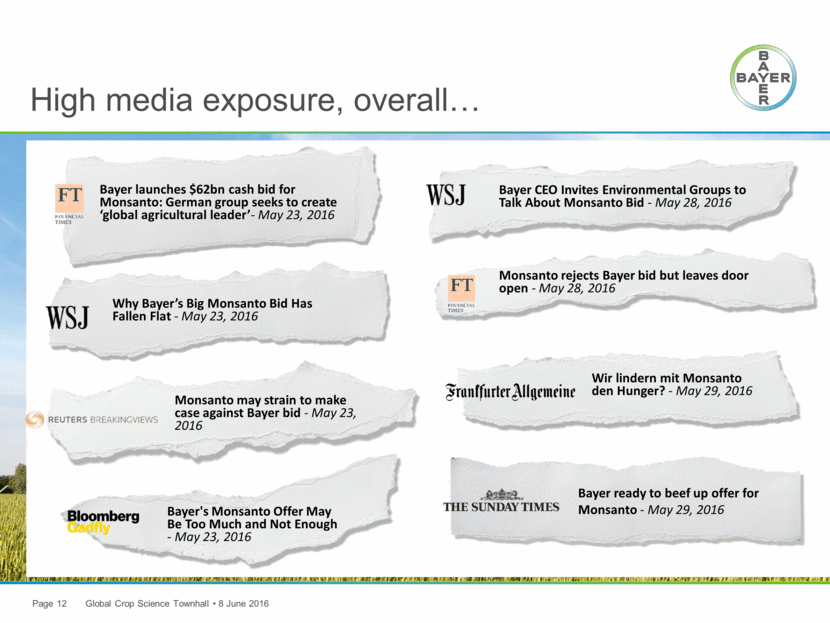
Transparency in Communications Stakeholder outreach Global News Releases TV statements provided (Baumann, Condon, Blome) Media and Investor Conference Calls Transaction website “Advancing together” launched TV appearances: Baumann on ARD, CNBC and Bloomberg TV Town Halls, Employee QA, Intranet Page 13 Global Crop Science Townhall • 8 June 2016
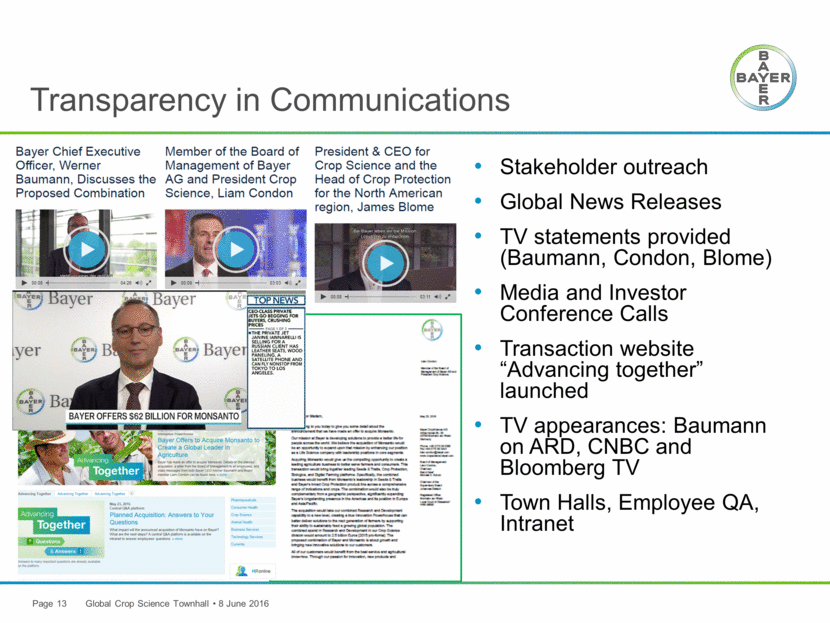
Next Steps Bayer is looking forward to discussions with Monsanto and is prepared to proceed immediately with due diligence and negotiations to achieve an agreed transaction Bayer is fully committed to this compelling transaction Page 14 Global Crop Science Townhall • 8 June 2016
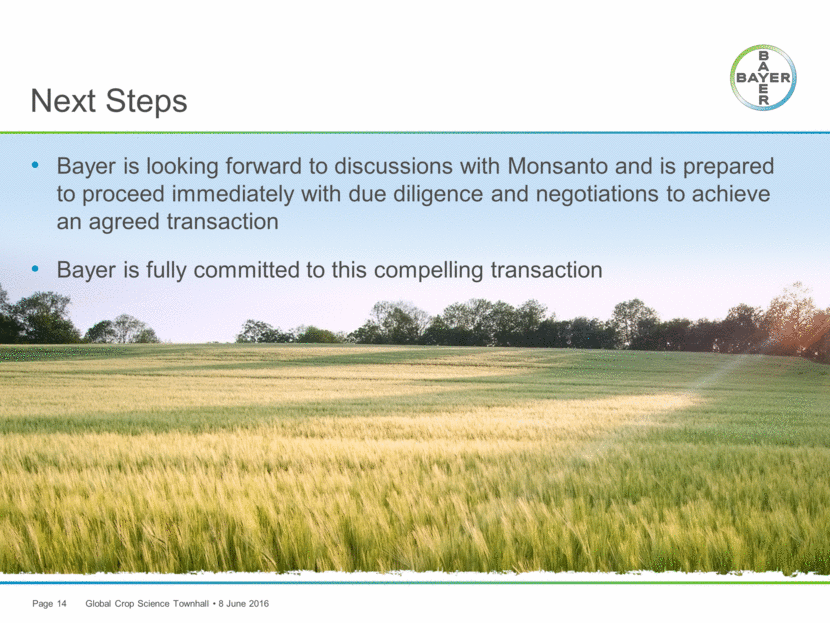
Thank you! Advancing, Together Global Crop Science Townhall • 8 June 2016
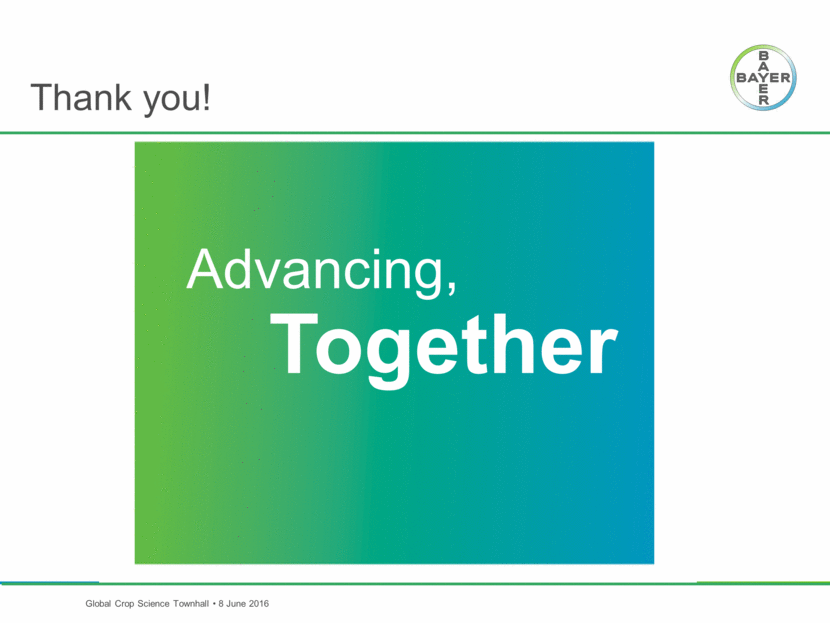
Exhibit 99.2
BAYER
TRANSFORMING TODAY, LEADING TOMORROW
Advancing Our Leadership Strategy
CROP SCIENCE GLOBAL TOWNHALL MEETING
8 June 2016
(2:30 p.m.)
MODERATOR: We’re going to do things a little bit differently. So first Liam will give us an update on our intentions to acquire Monsanto. Then we’re going to have a question-and-answer period on that. We’ll then move to updates on Advancing Our Leadership Strategy with Liam, with Marc, and with Adrian.
So this is what’s new. You can see Marc isn’t with us today in Bayer in Monheim. He’s actually in Brazil. So we’re going to do a little bit of experimentation. We’re going to keep our fingers crossed that technology works, and Marc is going to actually present from Brazil. Then we’ll do a question-and-answer session on that. So with that, let’s get started.
Liam.
LIAM CONDON: Thanks a lot, Beth. Good afternoon to everybody here in Monheim, Germany, in the site, and good morning to everybody in the Americas. Marc, happy birthday. He’s in Brazil today. It’s his birthday today, so he’s celebrating with his real friends, his old Brazilian friends. Of course, good evening to everybody in Asia/Pacific.
[Slide 2] I think just going through today, I have to point out this one legal disclaimer. You’ve all, I think, seen it many, many times, but I have to point it out to you once again. Once we talk about Monsanto, we have to draw your attention to this legal disclaimer.

[Slide 3] So what we’re going to talk about today, basically two big topics. One is all about the proposed acquisition of Monsanto, and we’ll immediately have a bit of Q&A around that. Then the second part is about what we call Advancing Our Leadership Strategy, which is about our next steps in our current strategy and what our concrete proposals are, what our conclusions are, how we want to take things forward. So these two parts. Marc from Brazil and Adrian here are going to help me; and, of course, we’ve got other EXCO members here who also will jump in whenever we have questions and we’ll try to give you our best answers.
It’s an awful lot of information today. I apologize in advance for that. Don’t get too caught up in the details because there’s an awful lot of stuff that you can read online and you will have lots of opportunities afterwards also with line management to go through further details. So today we want to try and focus on the big picture of where we’re going as a company and why we’re doing certain things, and you can use the opportunity then to ask questions. So that’s basically the way we want to play it.
To kick it off, I mean I have to say I’ve been asked throughout the years, basically ever since I joined Crop Science, I’ve kind of been asked multiple times: How serious is Bayer really about Crop Science? Is all the money going into pharma and consumer care? Are we really going to be committed in the future, going forward, to Crop. I’ve always given the answer, “Crop is an integral part of Bayer.” And I’ve also
noticed sometimes people in the audience smirking a little bit: Yeah, I wonder, I’m not so sure.
I think with our proposal to acquire Monsanto, which I hope was a very big surprise for all of you because it was supposed to be very secret, so it should have been a big surprise -- our proposal to acquire Monsanto is, of course, a tremendous recognition on the one side of our commitment to Crop and of the Bayer Group’s commitment to Crop but also a commitment towards our implementing our ongoing strategy.
[Slide 4] And we’ll go through very briefly a bit of the rationale. You’ve already seen a lot of information around this, why we’re doing this. It’s the biggest-ever deal out of Germany. It’s the biggest all-cash deal. This is huge, but the real rationale behind this is it’s kind of twofold. One is from a Bayer point of view, this really strengthens us as a life science company. This is at the end of the day our overall goal, to strengthen ourselves as a life science company. On the Crop side, this is basically a transformational move and puts us in a leading position in the industry. And that’s what’s really behind this. So it’s both important for the Bayer Group, otherwise the Bayer Group wouldn’t be willing to spend in excess of EUR 55 billion for this acquisition, and for Crop it’s an absolutely transformational move because the company we’ll be taking over is actuality even bigger than Crop Science today. So this in all accounts is really a very, very transformational move.
[Slide 5] Looking at it from different angles, I have to say that the element of surprise means, of course, a lot of people need to warm up to the idea. This wasn’t something that many people had on the radar screen that Bayer would ever be so bold as to make such a move. And this caught people, I would say both within our company and for sure outside of our company, caught a lot of people by surprise.
Our original intent had been to basically negotiate privately, reach a conclusion, and then basically go into explaining mode. That was impossible because at the end of the day there was an unfortunate leak, communications mishap at the Monsanto side. Then they had to confirm that they were in negotiations with us, and we had to confirm we were discussing with them. Then we had to start going into communication mode without having figured out or agreed on all of the details. So it’s not as clean as we would like it to be. Nonetheless, the story behind it is incredibly compelling.
So again I’ve already mentioned benefits for Bayer. For employees, particularly if you’re in Crop, 50% of the company would be Crop. And it’s not just the size of the company then. This would be by far the most innovative and leading company in the industry. So if you want to be part of something that’s really making a difference, this is the company to be.
From a Crop Science point of view, great complementarity from a product portfolio, us being largely crop protection dominated with a nicely growing seeds and traits business and a nice environmental science business. Basically at the end of the day, almost 90% of our business is crop protection today. Monsanto is largely a seeds and traits, broad acre company. And from a geographic point of view, great complementarity here.
Customers. The promise, the expectation is that we will deliver more innovation. This whole deal is not built on cost synergies or cost savings per se, and it’s not built on tax inversion or other kinds of logic. This deal, the whole logic behind it is innovation and growth.
For the investors -- and this is something we’ve been working on extensively in the past two weeks because, of course, they need to be convinced. These are basically our owners at the end of the day. We had a big surprise for investors, particularly for the investors who see us as a pharmaceutical company and they don’t mind having an agricultural piece in the company but they see us as a pharmaceutical company. If suddenly agriculture becomes 50% and that’s a cyclical business and they don’t really understand how that all works, then they have a lot of questions and want to know what’s this about and what’s behind this. At the end of the day, what we’ve been explaining now over the past two weeks is this tremendous value both for our own shareholders and for Monsanto’s shareholders. With that, after the initial shock you see the price, the share price gradually coming back now, which is simply because we’ve been explaining, which we couldn’t do before because it was all information that wasn’t in the public domain.
A big reminder again. Stay on the big picture. What are we talking about and what’s behind this. Again, a deal like this, 55 billion, we’re not doing this for the next quarter or for the next season or for next year. I mean this is something that lasts for decades. So we’ve got to look out decades: Where do we see the world going, where do we see agriculture going, and what role do we want to play?
I’ve tried to be very clear that I think at least Bayer should be and Crop Science should play a leading role. I honestly believe that the world of agriculture is better off having us as a leader than having somebody else as a leader.
[Slide 6] Just looking at the stats again, an additional 3 billion people on the planet by 2050. That’s six times the population of Europe. They all need to be fed. It’s not just 3 billion more people. There’s an awful lot more going to be middle-income moving from rural cities into the big cities, changing their diets, more demand for protein. And this of course means more demand for animals and more demand for feed. With that, more demand for soy, corn, wheat. So this is almost exponential growth.
The challenge is, at the end of the day, the land that we have available is limited, so we can’t just keep expanding land. And because population is growing much faster than the availability of arable land, the per capital availability of arable land is constantly declining. So it means we’ve got to produce more food on less land with less resources. There’s not going to be more water available in 2050. If you think about climate change, what’s happening is basically more extremes of heat, drought, on the one side, and flash-flooding on the other side. Both are bad for agriculture. Both make it more difficult to produce, sustainably produce enough food. So this is basically what we’re talking about and this will require a lot of innovation to make sure that we will be able to feed a growing population in a manner that is also sustainably compatible, that does not damage the environment and that does not harm biodiversity.
So this is a huge challenge going forward. It’s not just about productivity. It’s also a lot about environmental sustainability, and we’ve got to get that right. The only way we can do that is with more innovation than we currently have available. This is again the logic behind this deal that we’re convinced that, together with Monsanto, we’ll be able to generate more innovation than if we are just stand-alone. We’ll generate innovation as stand-alone, just not as much. That’s the difference.
[Slide 7] Again I’ve already outlined briefly on the one side you’ve got this tremendous crop protection focused portfolio and a geographic focus which is more European and to a degree Asian-related where our strengths are; and then Monsanto’s strengths are clearly seeds and traits and more the Americas, particularly North America and to a degree Latin America as well.
So these are the two portfolios that would tremendously complement each other. On top of that we’ve got the power then of big data and of digital farming, which is of course still an evolving area. But there is no reason to assume that digital farming will not have the same transformational impact on agriculture as digital has had on every single other industry. It’s not a question of if it’s going to happen; it’s just a question of when, how it’s going to happen, and who’s going to be in the leading position.
Here we see Monsanto clearly today in a pioneering role. They’ve made very substantial investments. The key thing is they’ve got access to an awful lot of data, and in a digital world, access to data is basically your most important currency. Then using that data to turn it into algorithms that can help you take smarter decisions, that’s where the real benefits come in. So this is where we see the tremendous benefits of this combination -- portfolio, geography-complementary, and all based with an underlying digital platform.
Conceptually, we talk a lot about integrated offerings, but we actually don’t see it very often in the market. At the end of the day, what we’re talking about is really a customized offering for growers that will help them take the right decisions, the best decisions to optimize their harvests, get the most out of their seeds, and do it with an optimized input cost and do it in a way that is again environmentally sustainable. To do that, you need a lot of data to be able to take all of those decisions in the best manner. This is something that we’re working on. We’ve got different examples of this working to a degree. We know with canola and cotton, we’ve got wonderful examples that already work today without any kind of a strong digital component but we’re also convinced here, with a stronger digital component, it can be an even more compelling offering.
What we don’t have is a true integrated offering in the broad acre crops, soy, corn, wheat, which has been less important as a commercial seed; and here there’s tremendous opportunity together with Monsanto to actually bring this model to the market.
[Slide 9] On the numbers side from an innovation point of view, I think it’s very important to point out -- and I kind of refer to it again and again and again -- this whole deal is built around innovation. That’s why it fits so much to us, because we are at the end of the day an innovation company. We would have the broadest portfolio, we would have access to the broadest array of technologies in the industry, and we would have the investment ability to make sure that we could generate true innovation. If you see the numbers here, these are pro forma examples, so just kind of adding the numbers of 2015 together to give an indication, a trend of where things could be.
What you can see is basically we would have pro forma spending in 2015 of EUR 2.5 billion. I think the important point is if you look at the next competitor, it’s 50% more than the next competitor, which means the probability that we can generate more innovation than the following competitors, if we do things right, is simply higher. If we do things wrong, we’re wasting money; but if you assume we’ve got great people in R&D and we’re spending the money on the right things, just having this ability to invest is what will drive growth for the future.
A final point I would just make here. Again if you look at it from an overall market position point of view, I remember being asked this several times also in previous townhalls: With all of the changes that are going on and we’re still talking about a leadership strategy, so if we’re No. 4 or 5, why are we talking about a leadership strategy? And I said at the time there are always options. And a little bit, of course, implying, well, trust us as a management team. We’re not only working on organic options, we’re also always looking at alternative paths forward. And what I said at
the time is it’s not so much important when or if you’re technically the biggest or No. 1 or whatever your market size per se. What’s much more important is the leadership mindset and a commitment, a true commitment to innovation. That is what ultimately makes the difference.
In this new world scenario, we would have by far the leading position. With that we would also have the most responsibility, actually not just in the industry but in the world, to make sure that we can grow or can feed a growing world in a sustainable way. That is a tremendous responsibility that we would carry going forward. We have that responsibility today but not to the extent that we would have it in the future with this transaction. That requires as well that we then not only think but also behave as a true leader and as a responsible leader.
[Slide 13] So reception to this, overall. I mean I could paraphrase it and say that when things broke immediately -- we have on social media the nice term “shit storm” to summarize what the immediate feedback was. Of course, because it was such a surprise to so many people, caught a lot of people off guard, a lot of people were wondering what on earth is going on, what is Bayer doing here, and is this really part of the strategy, and have those guys gone nuts. There was a lot of interesting feedback about what was going on in the market or how the reception was in the market.
I’d say there’s been very different feedback in different parts of the world.
If you were to categorize it, I’d say media and investors have concern in Europe, particularly in Germany and France. That has a lot to do with the reputation of Monsanto. This is kind of the single biggest issue.
In America, a very different reception. When we were there last week, interestingly the topic of reputation doesn’t come up at all. It’s not an issue and I’m not sure whether it’s because Bayer is not so well known in the U.S. or Monsanto has a less bad reputation or a stronger or more positive reputation in the U.S. It’s not quite clear. Much more openness to discuss in the U.S. Much more willingness to actually see the strategic rationale behind this, and a lot more, I would say, appreciation of agriculture. The importance of agriculture is in the Americas simply clearly a very dominant societal and political topic. With that, there’s a lot of support for agriculture on average, compared with Europe where it’s anything related to kind of big agriculture is perceived relatively negatively because it’s often perceived as being damaging for the environment and potentially damaging for small holders.
So a lot of work to do in Europe. In the U.S., much more open reception, and I would say in Asia/Pacific on average more neutral. So this has been the feedback so far.
[Slide 15] We’ve tried to be as open and clear and transparent as we can be. I mean, you’ll have seen videos. We’ve had the Q&A’s. We’re basically communicating
across the board on all channels. All our coms people, our PGA people are constantly out there talking, giving background and briefing both media, who really want to know what’s going on, and politicians who really want to know what’s behind this.
I think after the initial shock now, things have moved on to more of a position where you’re starting to see more balanced media reporting and also relatively balanced political opinions coming back now. And at least on the political side and regulatory side, the feedback we’ve been getting is relatively encouraging. You could have expected it to be more negative for a deal of this size. It’s actually quite encouraging because a lot of people can see the rationale behind it and they understand the need for more innovation and they do see Bayer as a trustworthy company and with a very strong reputation that will, they assume, do the right thing. So it’s good feedback that we’re getting right now, very helpful overall for us. And as we go along, we’re constantly adapting then our strategy going forward from a communications point of view, depending on what the highlight topics are.
[Slide 16] Next steps. We’ve clearly said our intention, and this is the agreement with Monsanto is rather to go back to a private negotiation and to do less through the media. We had to communicate through the media. Now we would rather enter a negotiation process and due diligence. This is still pending. So we are only at the very beginning. At Bayer, we’re very committed to the transaction and we’re looking forward to engaging with Monsanto.
I think a positive thing, this is quite different than the scenario with Monsanto when they were trying to take over Syngenta. They never actually got to a situation that they were talking to each other. That entire thing just went through the media. In this case we are talking to each other. So there is conversation going on, we’re just not at a stage that we’re formally sitting around a table negotiating and doing due diligence. So that’s kind of the difference of where we are.
So that’s basically it on Monsanto, where we are. Again, you’ve got an awful lot of background information through other channels and I’m sure you have also gotten feedback from your neighbors and your friends and a lot of other people and I’m sure you’ve had time now to form an opinion yourself whether this is good or bad. But what I would offer right now before we move on to the next topic is an opportunity for you to ask questions now. You’ve seen a big Q&A catalog on the Internet hopefully, but there’s an opportunity now to ask questions that you think maybe have not been properly covered so far. I would gladly try to address them before we move on with the next part.
MODERATOR: Thank you, Liam.
So we’ll first start with questions from here in Monheim. For those of you that are dialing in, please put your questions in through the web-based tool. So we have a couple of folks at the microphone here if you’re interested in asking a question.
QUESTION: What’s your expectation with respect to time lines going forward with Monsanto?
LIAM CONDON: The short answer is we really don’t know because it depends on their willingness to enter negotiations.
The longer answer is a more reliable time frame up until closure you have to assume is at least probably 12 months. This has to do with regulatory issues. So to get all of the necessary regulatory approvals around the world for a deal of this magnitude, it will take probably at least 12 months. So if we were to conclude -- and we don’t know if we will -- but if we were to conclude, it would be earliest middle of next year, just to put a realistic time frame.
Up until middle of next year at the very earliest, nothing changes for anybody at Crop Science. We still need to meet all our numbers every quarter. We still need to keep doing our jobs because nothing in that respect changes for the foreseeable future, for the next 12 to 18 months.
MODERATOR: Other questions here in Monheim?
You can think, and we’ll go to the ones from the computer.
QUESTION: We keep emphasizing that public acceptance is something we really have to work on. Won’t it set us back here if we are associated with Monsanto?
LIAM CONDON: Again, it’s a great point. The whole reputation and trust issue come up with media, with investors, with the public and neighbors. Particularly Germany and France are the two strongest areas where it comes up, where also Monsanto has the most negative image. In again different parts of the world, Monsanto has a different image. It’s not all bad. In America, Monsanto is also an employer of choice. People who work for Monsanto are very proud to work for Monsanto because it’s seen as a great employer.
The issue for us at the end of the day now, going forward. We have a huge understanding about the need for societal acceptance. This is partially related also to the different businesses we’re in, partially related also to the fact that we have a consumer business so we would kind of have a direct line, also on the healthcare side, to an awful lot of consumers. And I think it’s been clear to us for quite some time that it’s not enough to just have great products and great people. You need a degree of trust in society and to have a license to operate. That’s why we talk so much about the license to operate.
I’ve had discussions also with Hugh Grant and other colleagues in Monsanto; and they will openly admit they were for such a long time so convinced of this technology and science and innovation they had, they didn’t see a need to explain it. All they saw was a need to explain it to the farmer who ultimately bought it, but not beyond that. This is an area where they simply didn’t invest enough, and ultimately way too late. So from our side, there’s a clear commitment that we would be -- we would, of course, invest very heavily in gaining that and maturing and strengthening that societal trust and that bonus that we have as Bayer.
It’s clear as well we are acquiring Monsanto because of the people, the products, the portfolio, the technologies they have, not because of the brand Monsanto. That is not the reason that we would acquire -- and we could probably help Monsanto to overcome their image issues.
And a final point on this. What’s also very clear, we have one set of business practices as Bayer and that is the highest ethical standard possible. Any business we acquire, they all have to operate to the same standard. That’s a commitment that we give all the time to society, and it’s something that we would have to explain and again make the commitments to society that we can keep. But I do think with an adequate investment explanation, it is possible to address this issue.
Reality is, it’s actually very interesting to see, Monsanto is probably one of the most well-known companies in Europe, certainly in Germany and France. It has a tiny business in Europe. The business has no proportion whatsoever to the image of the company. If there was a correlation between the two, it would be a completely different world. And in countries where Monsanto has a big business, they have a much better reputation. So it is interesting to see that correlation.
Again, it’s part of our policy to engage in dialogue, transparency, and outreach also to NGOs and to explain what’s behind this deal and why it will ultimately be good for both farmers and society. That’s a process we have to engage in. Again, it comes back to our responsibility. We will be a much bigger company with a lot more societal responsibility and with that a lot more obligation to explain why what we’re doing is so important.
MODERATOR: Thank you, Liam.
Questions here from the room in Monheim?
We do have another one from online.
QUESTION: The Monsanto bit wasn’t asked for. Don’t you expect negative vibes from the colleagues there? Negative vibes.
It wasn’t asked for, meaning it wasn’t expected. Do you expect a smooth integration?
LIAM CONDON: Yes, also a very important point. The whole topic of integration. Again, any deal like this, I always say it’s people, products, portfolio; but it starts with the people. If you lose the people, you’re not buying that much.
We need the skills and the competencies of the people at Monsanto to make sure this deal works. So initially, of course, there’s noise, there will be some disturbance, and particularly in the U.S. where Monsanto is very big, very dominant, has their headquarters. They will be kind of wondering what’s kind of going on. I think through the process there will be communication from their management first. We can’t communicate with their people. We can only do that when we have reached an agreement. Once we have reached an agreement, we would then very quickly work on the integration side and explain what our vision is for the company going forward and be very clear. Again, we need the people, the competencies, the skills that Monsanto brings. So I think there will be noise for sure. People will be unsettled.
What helps us a little bit -- and I don’t mean that in any kind of a funny way -- our industry is consolidating heavily and most of our competitors in the U.S. are downsizing. Dow and DuPont have gone together. Everybody is cutting back. Most of them are in job-cutting mode. So the risk of great people jumping, going somewhere else is relatively low in this type of an environment. My bigger concern would rather be the engagement, maintaining the high engagement level of the people; but that is only something we can start to tackle once we have an agreed setup basically. So that would be a future step to be tackled.
I think what will help us just culturally -- again there might be different perceptions -- is the company is completely committed to innovation and science. They like to win as well. I think these are two elements that we can share with each other. And I remind our people, as well in the U.S. and sometimes also investors in the U.S. asking about integration and will we be able to manage culturally. It’s quite interesting as a Bayer groups we have more employees in the U.S. than Monsanto. We’ve actually
been present in the U.S. longer than Monsanto. We’ve been there over 150 years; Monsanto just over 100 years. Again, we have 14,000 employees versus their 11,000 -- as a Bayer Group. So we have a strong footprint. We know how to operate successfully in the U.S., and we will try and convince the future colleagues of that if we get the opportunity.
MODERATOR: Thank you.
Other questions here. We’ve got a question up front, if we can get the microphone, please.
QUESTION: You said from this stakeholders’ point of view, from the different stakeholders you have mentioned what you need for these synergistic alliances, for this merger. If you put in the perspective of seeing from the farmer’s side, these stand-alone companies offering suppose what company today. Tomorrow with this togetherness, how this synergy can take more for the farmers.
LIAM CONDON: So I think there will be always be a concern among farmers and intermediaries of distribution if you have such a consolidated industry, will this be bad for me. Less choice, higher prices, that’s kind of the big concern. Ultimately if you look at this from the portfolios that are involved, because they’re so complementary. Nothing really changes on the seed side, the availability of seeds. Nothing really changes on the availability of the crop protection side. Higher prices are only possible if you’re bringing some benefit to the market.
This is where we truly see an opportunity to really have a step change in innovation with a complete portfolio and optimizing all inputs simultaneously, also with the power of big data, digital farming, as opposed to optimizing a part of the system, so just the crop protection component or just the seed component. So if we can optimize the system, we’re convinced we can get higher yields with less input cost and ultimately a higher return on investment for farmers.
So that’s the proposal. If we can’t deliver on that, we will not be competitive. And there’s still enough competition out there to make sure that if we don’t deliver, we won’t get paid. So that’s how we will be and want to position to farmers. So I would say judge us on what we deliver and not just on promises.
MODERATOR: Other questions from here in Monheim?
Our Q&A document must have been fabulous on the website. Awesome communication.
LIAM CONDON: No lawyers in the room.
MODERATOR: We’ve got one question in here. We’ve got one more online coming in. So Liam they’re asking will our regional focus shift if the merger goes through. Will North America become much more important than India?
LIAM CONDON: The regional focus will -- sales per region will change very much. I wouldn’t say one region is necessarily more important than the other, but what will be very clear is we would have a very strong setup in North America. The North American sales of the combined company would be higher than Crop Science alone today. So this is a huge company in North America. Very competitive position in Latin America. Very competitive position in Europe. In Asia/Pacific versus the other R&D companies, we would have a very competitive position. Versus generic players we would still only be one of many, many players. So we’d still have, I’d say, quite a balanced geographic portfolio in all regions, but relatively we would be somewhat overweight in the high value, highest value North American market for sure.
MODERATOR: Thank you. So any other questions from here in Monheim?
In the back. If you’ll wait for the microphone, please.
QUESTION: After this deal, are you going to stay with us?
LIAM CONDON: I think my boss would kill me if I left after this deal. Yeah, I mean this is -- it’s a transformational deal and, of course, there’s a huge personal commitment from me but also from our EXCO because we have to agree that this is something we want to do. There’s a huge commitment from the Board of Management, and we had a unanimous decision at the Board of Management to do this. So we also have the head of Pharma, the head of Consumer Care. They could have abstained from this. They all voted in favor. And the entire Supervisory Board, which also includes half of the Supervisory Board is employee reps in Germany, also the entire Supervisory Board supported this unanimously. So there’s full management
support and from my side personally full commitment and dedication. I would see it as an obligation. If you start something, you’ve got to see it through.
MODERATOR: Good answer. Any other questions from here in Monheim? We have no more on the website, on the web tool either.
Going once, going twice. If not, we can move on to Advancing Leadership.
Exhibit 99.3

During our Global Town Hall Meeting I provided an update on the proposed acquisition of Monsanto. Whereas we do not yet know if the proposed acquisition will be successful, we do know what we need to do today to ensure we can continue to grow in future.
The proposed acquisition of Monsanto represents a major step forward for our Crop Science business and would reinforce Bayer as a pure Life Science company with leadership positions in our core business segments.
With Monsanto, we would create a fully integrated leader in Crop Science and would be able to offer a broad product portfolio across Seeds & Traits, Crop Protection, Biologics and digital farming. Together, we would be an innovation powerhouse helping to prepare the industry for the next generation of farming.
The proposed transaction is driven by our strong belief that this combination would be a powerful response to the enormous challenges our industry has to take on in order to feed a growing world population. These fundamental challenges affecting the ag industry can directly be translated into a new set of requirements farmers must take into account while conducting their business.
This proposed combination of Bayer and Monsanto would form a new global leader in an industry worth about €85 billion. And we believe that would allow us to deliver a new set of offerings for the next generation of farming that would include:
· Tailor-made solutions for individual farmers catering to their very complex requirements across different geographies and products
· R&D capability at scale to be at the forefront of innovation, and
· Digital farming solutions which leverages technology to a maximum for farmers and the environment.
You can find more information online: https://www.advancingtogether.com/en/home/ or if you have questions, you can utilize the online tool http://de.bayernet.cnb/en/service/news-overview/global/2016/06/06/qaa-monsanto.aspx
For now, please continue to stay focused on what you can directly influence, which is the achievement of our 2016 business goals. Thank you for your continued support and commitment to shaping the next generation of farming.
Best Regards,
Liam Condon
Forward-Looking Statements
This communication may contain forward-looking statements based on current assumptions and forecasts made by Bayer management. Various known and unknown risks, uncertainties and other factors could lead to material differences between the actual future results, financial situation, development or performance of the company and the estimates given here. These factors include those discussed in Bayer’s public reports which are available on the Bayer website at www.bayer.com. The company assumes no liability whatsoever to update these forward-looking statements or to conform them to future events or developments.
Additional Information
This communication relates to a proposed offer by Bayer Aktiengesellschaft or its subsidiaries (“Bayer”), to purchase all of the outstanding shares of common stock, par value $0.01 per share, of Monsanto Company, a Delaware corporation (“Monsanto”). This communication is neither an offer to purchase nor a solicitation of an offer to sell shares of Monsanto. No tender offer for the shares of Monsanto has commenced at this time. At the time a tender offer for the shares of Monsanto is commenced, Bayer will file tender offer materials (including an Offer to Purchase, a related Letter of Transmittal and certain other offer documents) with the Securities and Exchange Commission (the “SEC”) with respect to the tender offer. Any definitive tender offer documents will be mailed to the stockholders of Monsanto. STOCKHOLDERS OF MONSANTO ARE URGED TO READ THE RELEVANT TENDER OFFER MATERIALS WHEN THEY BECOME AVAILABLE BECAUSE THEY WILL CONTAIN IMPORTANT INFORMATION ABOUT THE TENDER OFFER THAT STOCKHOLDERS SHOULD CONSIDER BEFORE MAKING ANY DECISION REGARDING THE TENDER OF THEIR SHARES. Stockholders of Monsanto will be able to obtain free copies of these documents (if and when available) and other documents filed by Bayer with the SEC through the website maintained by the SEC at www.sec.gov.
Serious News for Serious Traders! Try StreetInsider.com Premium Free!
You May Also Be Interested In
- Konsolidator maintains its financial expectations for 2024
- iZafe Group's Quarterly Report January-March 2024
- Transaction in Own Shares
Create E-mail Alert Related Categories
SEC FilingsSign up for StreetInsider Free!
Receive full access to all new and archived articles, unlimited portfolio tracking, e-mail alerts, custom newswires and RSS feeds - and more!



 Tweet
Tweet Share
Share